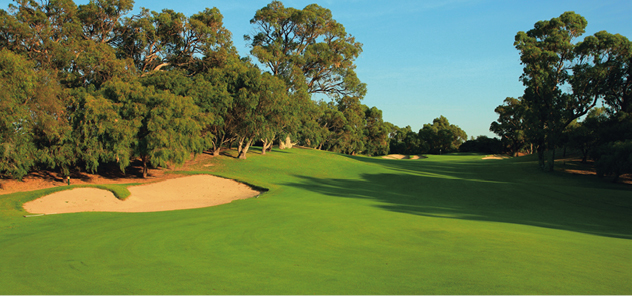
Cottesloe is internationally renowned for its superb beach, backing on to rows of towering Norfolk Island pines and wonderful terraced lawns, an idyllic spot to soak up views of the Indian Ocean. If you were expecting to find Cottesloe Golf Club in this pretty suburb of Perth, you’d be nearly 80 years too late.
The club started out in 1908 as a nine-hole course on the site occupied today by Sea View Golf Club – a stone’s throw, as the name suggests, from the water. The early 1920s saw several 18-hole courses spring up, and so that Cottesloe might be able to follow suit a move to nearby Swanbourne was mooted. Club professional David Anderson spent nearly two years carving the holes out of scrub, routing them through and over sand hills, with the help of a horse and plough. The new course opened for play in 1931.
Over the ensuing decades the cream of Australian golf – von Nida, Nagle, Thomson – walked Cottesloe’s fairways. The quality of the course was reflected in the standard of homegrown players. Graham Marsh, the late Roger Mackay and Brad King were all Cottesloe club champions. Anderson’s original layout remained unchanged until 1980 when Peter Thomson and Mike Wolveridge made some major alterations, bringing about a change in the course’s boundaries.
In 1994 Marsh, who is still a club member, was commissioned to come up with a masterplan. A decade-long rebuilding program began and was completed in time for the club’s centenary in 2008. The new Marsh layout, combined with the impeccable conditioning of the playing surfaces, has vaulted this undulating par-72 into the top echelon of Australian golf courses.
While some length was added to the course, it is the modern bunkering and new green complexes that really impress. The view from the elevated 1st tee sets the scene. The fairway of this seemingly tame 274-metre par-four dips into a valley before rising gradually. Large Melbourne sandbelt-style bunkers cut into the fairway from the right, while more bunkers can be found left of the sloping green. Long hitters might fancy their chances of reaching the green from the tee – a hefty 259-metre carry over the bunker just short of the putting surface. But with a helpful sea breeze, it’s certainly a tempting little proposition that Marsh offers up first.
The diversity of Cottesloe’s par-fours is one of its strengths. After the short opening hole, the next two-shotter is the 397-metre 3rd, where your drive must hug the left edge of the fairway to give yourself the best possible view of the green. Again, bunkers short of the putting surface will penalise anything mishit, while missing the green right can see your ball sail out of bounds.
Perhaps Cottesloe’s best two-shot hole is its longest: the dogleg-right, 400-metre 10th. From an elevated tee, players must drive on to a plateau that lies short of a fairway bunker about 210 metres away. If you are less than perfect with your tee shot, your approach to the green will be blocked by a clump of big tuart and peppermint trees. Even if you do hit it just right and earn yourself a clear view of the raised, multi-tiered green, you will see there is plenty of sand to dodge in your bid to make par.
Cottesloe is a private course. Members of interstate or overseas clubs with an official handicap can apply for a round, outside competition times, through the general manager.
|
MEMORABLE HOLES 1st, 3rd, 5th, 10th, 11th, 14th and 16th WHERE TO GO 173 Alfred Rd, Swanbourne, WA 6010 BOOK A ROUND (08) 9384 3222, www.cottesloegc.com OTHER 120 GREAT COURSES NEARBY Lake Karrinyup (14 km), Mt Lawley (15.2 km), The Western Australian (16.5 km) WHERE TO STAY Cottesloe Beach is 4 km south of the course. Accommodation options include the self-contained Cottesloe Beach Chalets, close to shopping, restaurants and bars. BEFORE/AFTER YOUR ROUND Grab some fish and chips, sit on the grass and watch the fabulous Indian Ocean sunset over Cottesloe Beach. |
